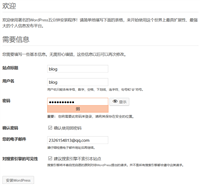conime,公务员报名人数查询,lass.exe
lnmp是一套技术的组合,l=linux、n=nginx、m~=mysql、p~=php
首先nginx服务是不能处理动态请求,那么当用户发起动态请求时, nginx又是如何进行处理的。
当用户发起http请求,请求会被nginx处理,如果是静态资源请求nginx则直接返回,如果是动态请求nginx则通过fastcgi协议转交给后端的php程序处理,具体如下图所示



1.用户通过http协议发起请求,请求会先抵达lnmp架构中的nginx
2.nginx会根据用户的请求进行判断,这个判断是有location进行完成
3.判断用户请求的是静态页面,nginx直接进行处理
4.判断用户请求的是动态页面,nginx会将该请求交给fastcgi协议下发
5.fastgi会将请求交给php-fpm管理进程, php-fpm管理进程接收到后会调用具体的工作进程warrap
6.warrap进程会调用php程序进行解析,如果只是解析代码php直接返回
7.如果有查询数据库操作,则由php连接数据库(用户 密码 ip)发起查询的操作
8.最终数据由*mysql->php->php-fpm->fastcgi->nginx->http->user
注意:php和mysql建立连接,一定是开发建立连接
1.php想连接数据库,必须安装php-mysqlnd
2.php连接数据库,必须通过代码连接
[root@web01 ~]# vim /etc/yum.repos.d/nginx.repo [nginx] name=nginx repo baseurl=http://nginx.org/packages/centos/7/$basearch/ gpgcheck=0 enabled=1
[root@web01 ~]# groupadd www -g 666 [root@web01 ~]# useradd www -u 666 -g 666 -s /sbin/nologin -m
[root@web01 ~]# yum install -y nginx
[root@web01 ~]# vim /etc/nginx/nginx.conf user www;
[root@web01 ~]# systemctl start nginx [root@web01 ~]# systemctl enable nginx
http://10.0.0.7
#卸载系统自带的php5.4 [root@web01 ~]# yum remove php-mysql-5.4 php php-fpm php-common 方法一: #配置第三方源 [root@nginx ~]# vim /etc/yum.repos.d/php.repo [php-webtatic] name = php repository baseurl = http://us-east.repo.webtatic.com/yum/el7/x86_64/ gpgcheck = 0 [root@web02 ~]# yum -y install php71w php71w-cli php71w-common php71w-devel php71w-embedded php71w-gd php71w-mcrypt php71w-mbstring php71w-pdo php71w-xml php71w-fpm php71w-mysqlnd php71w-opcache php71w-pecl-memcached php71w-pecl-redis php71w-pecl-mongodb 方法二: #更改php源 yum install http://rpms.remirepo.net/enterprise/remi-release-7.rpm #安装php [root@nginx ~]# yum -y install php71-php php71-php-cli php71-php-common php71-php-devel php71-php-embedded php71-php-gd php71-php-mcrypt php71-php-mbstring php71-php-pdo php71-php-xml php71-php-fpm php71-php-mysqlnd php71-php-opcache php71-php-pecl-memcached php71-php-pecl-redis php71-php-pecl-mongodb
[root@web01 conf.d]# vim /etc/php-fpm.d/www.conf user = www group = www
[root@web01 conf.d]# systemctl start php-fpm [root@web01 conf.d]# systemctl enable php-fpm
root@nginx ~]# cat /etc/nginx/conf.d/php.conf
server {
listen 80;
server_name php.driverzeng.com;
root /code; #注意站点目录分类
index index.php ;
location ~ \.php$ {
fastcgi_pass 127.0.0.1:9000;
fastcgi_param script_filename $document_root$fastcgi_script_name;
include fastcgi_params ;
}
}
#写index.php
[root@web02 wordpress]# vim index.php
<?php
phpinfo();
?>
yum install -y mariadb-server
[root@web01 ~]# systemctl start mariadb [root@web01 ~]# systemctl enable mariadb
站点目录下
<?php
$servername = "localhost";
$username = "root";
$password = "zls123.com";
// 创建连接
$conn = mysqli_connect($servername, $username, $password);
// 检测连接
if (!$conn) {
die("connection failed: " . mysqli_connect_error());
}
echo "小哥哥,php可以连接mysql...";
?>
<img style='width:100%;height:100%;' src=https://www.driverzeng.com/zenglaoshi/php_mysql.png>
[root@web01 ~]# mysqladmin -uroot password 'zls123.com'
[root@web01 ~]# mysql -uroot -pzls123.com
#查看有哪些数据库 mariadb [(none)]> show databases; +--------------------+ | database | +--------------------+ | information_schema | | mysql | | performance_schema | | test | +--------------------+ #创建数据库 mariadb [(none)]> create database wordpress; query ok, 1 row affected (0.00 sec) ------ #使用库 mariadb [(none)]> use wordpress; #查看前缀 mariadb [wordpress]> show tables; #退出 mariadb [wordpress]> \q 或者exit
[root@web02 code]# tar xf latest-zh_cn.tar.gz
[root@web02 code]# chown -r www.www /code/
注意:状态码413,报错,上传文件nginx下
解决方法
[root@web01 wordpress]# vim /etc/php.ini
/size修改尺寸 2处
[root@web01 wordpress]# vim /etc/nginx/conf.d/blog.drz.com.conf
server {
listen 80;
server_name blog.drz.com;
root /code/wordpress;
index index.php ;
client_max_body_size 10m; #修改尺寸
location ~ \.php$ {
fastcgi_pass 127.0.0.1:9000;
fastcgi_param script_filename $document_root$fastcgi_script_name;
include fastcgi_params;
}
}
能够解决
| 主机名称 | 应用环境 | 外网地址 | 内网地址 |
|---|---|---|---|
| web01 | nginx+php | 10.0.0.7 | 172.16.1.7 |
| db01 | mysql | 172.16.1.51 |
1)导出源数据库中的数据
[root@web02 ~]# mysqldump -uroot -pzls123.com -b wordpress > /tmp/wordpress.sql
2)将导出的数据,传到新数据库的服务器上(mariadb必须开启)
[root@web02 code]# scp /tmp/wordpress.sql 172.16.1.51:/tmp
3)在db01服务器上,安装数据库
[root@db01 ~]# yum install -y mariadb-server
4)启动数据库并加入开机自启
[root@db01 ~]# systemctl start mariadb [root@db01 ~]# systemctl enable mariadb
5)设置mysql密码
[root@db01 ~]# mysqladmin -uroot -p password 'zls123.com'
6)将导出的数据,导入数据库内
[root@db01 ~]# mysql -uroot -pzls123.com < /tmp/wordpress.sql
7)连接数据库并查看
[root@db01 ~]# mysql -uroot -pzls123.com mariadb [(none)]> show databases; +--------------------+ | database | +--------------------+ | information_schema | | mysql | | performance_schema | | test | | wordpress | +--------------------+ #查看库中的表 mariadb [(none)]> show tables from wordpress; +-----------------------+ | tables_in_wordpress | +-----------------------+ | wp_commentmeta | | wp_comments | | wp_links | | wp_options | | wp_postmeta | | wp_posts | | wp_term_relationships | | wp_term_taxonomy | | wp_termmeta | | wp_terms | | wp_usermeta | | wp_users | +-----------------------+
8)停止旧的数据库
[root@web02 code]# systemctl stop mariadb
9)测试连接数据库
[root@web02 ~]# mysql -uroot -pzls123.com -h172.16.1.51
报错:
[root@web02 ~]# mysql -uroot -pzls123.com -h172.16.1.51 error 2003 (hy000): can't connect to mysql server on '172.16.1.51' (113) #关闭防火墙 [root@db01 ~]# systemctl stop firewalld
[root@web02 ~]# mysql -uroot -pzls123.com -h172.16.1.51 error 1130 (hy000): host '172.16.1.8' is not allowed to connect to this mariadb server #授权用户允许远程连接 mariadb [(none)]> grant all on wordpress.* to wp@'172.16.1.%' identified by 'zls123.com';#注意一一对应
10)创建远程连接mysql的用户
db01#授权用户允许远程连接 mariadb [(none)]> grant all on wordpress.* to wp@'172.16.1.%' identified by 'zls123.com'; mariadb [(none)]> select user,host from mysql.user; +------+------------+ | user | host | +------+------------+ | root | 127.0.0.1 | | wp | 172.16.1.% | | root | ::1 | | | db01 | | root | db01 | | | localhost | | root | localhost | +------+------------+
11)编辑php代码连库文件
[root@web02 ~]# vim /code/wordpress/wp-config.php // ** mysql 设置 - 具体信息来自您正在使用的主机 ** // /** wordpress数据库的名称 */ define( 'db_name', 'wordpress' ); /** mysql数据库用户名 */ define( 'db_user', 'wp' ); /** mysql数据库密码 */ define( 'db_password', 'zls123.com' ); /** mysql主机 */ define( 'db_host', '172.16.1.51' ); 方法二:zh的修改 [root@web01 zh]# grep -r "zls123.com" ./* system/config/database.php: 'password' => 'zls123.com', [root@web01 zh]# vim /code/zh/system/config/database.php 'host' => '172.16.1.51', 'username' => 'zls', 'password' => 'zls123.com', 'dbname' => 'zh',
12)重启php
[root@web02 ~]# systemctl restart php-fpm
13)测试数据库连接
[root@web02 ~]# mysql -uwp -pzls123.com -h172.16.1.51
14)打开浏览器访问
优点
cd /解压目录下 [root@web02 nginx_php_mariadb]# yum install -y ./*.rpm
[root@web02 conf.d]# scp ./* 172.16.1.8:/etc/nginx/conf.d/ [root@web01 ~]# scp -r /code 172.16.1.8:/
[root@web01 ~]# groupadd www -g 666 [root@web01 ~]# useradd www -u 666 -g 666 -s /sbin/nologin -m
[root@web01 ~]# vim /etc/nginx/nginx.conf [root@web01 ~]# vim /etc/php-fpm.d/www.conf
[root@web01 ~]# chown -r www.www /code/
[root@web01 ~]# systemctl start nginx php-fpm [root@web01 ~]# systemctl enable nginx php-fpm
注意:1.白屏,没有将库导入到新库下,
2.建立连接时路径,一一对应,数据库改权限时
| 主机名称 | 应用环境 | 外网地址 | 内网地址 |
|---|---|---|---|
| web01 | nginx+php | 10.0.0.7 | 172.16.1.7 |
| web02 | nginx+php | 10.0.0.8 | 172.16.1.8 |
| nfs | nfs | 172.16.1.31 | |
| db01 | mysql | 172.16.1.51 |
[root@nfs ~]# yum install -y nfs-utils
[root@nfs ~]# vim /etc/exports #wordpress静态资源共享目录 /data/wordpress 172.16.1.0/24(rw,sync,all_squash,anonuid=666,anongid=666) #wecenter静态资源共享目录 /data/zh 172.16.1.0/24(rw,sync,all_squash,anonuid=666,anongid=666) #edusoho静态资源共享目录 /data/edusoho 172.16.1.0/24(rw,sync,all_squash,anonuid=666,anongid=666)
[root@nfs ~]# systemctl start rpcbind nfs-server [root@nfs ~]# systemctl enable rpcbind nfs-server
[root@nfs ~]# cat /var/lib/nfs/etab /data/edusoho 172.16.1.0/24(rw,sync,wdelay,hide,nocrossmnt,secure,root_squash,all_squash,no_subtree_check,secure_locks,acl,no_pnfs,anonuid=666,anongid=666,sec=sys,rw,secure,root_squash,all_squash) /data/zh 172.16.1.0/24(rw,sync,wdelay,hide,nocrossmnt,secure,root_squash,all_squash,no_subtree_check,secure_locks,acl,no_pnfs,anonuid=666,anongid=666,sec=sys,rw,secure,root_squash,all_squash) /data/wordpress 172.16.1.0/24(rw,sync,wdelay,hide,nocrossmnt,secure,root_squash,all_squash,no_subtree_check,secure_locks,acl,no_pnfs,anonuid=666,anongid=666,sec=sys,rw,secure,root_squash,all_squash)
[root@nfs ~]# groupadd www -g 666 [root@nfs ~]# useradd www -u 666 -g 666 -s /sbin/nologin -m
[root@nfs ~]# mkdir /data/{wordpress,edusoho,zh} -p
[root@nfs ~]# chown -r www.www /data/
[root@web01 ~]# yum install -y nfs-utils [root@web02 ~]# yum install -y nfs-utils
[root@web01 ~]# showmount -e 172.16.1.31 export list for 172.16.1.31: /data/edusoho 172.16.1.0/24 /data/zh 172.16.1.0/24 /data/wordpress 172.16.1.0/24 [root@web02 edusoho]# showmount -e 172.16.1.31 export list for 172.16.1.31: /data/edusoho 172.16.1.0/24 /data/zh 172.16.1.0/24 /data/wordpress 172.16.1.0/24
[root@web01 ~]# scp -r /code/wordpress/wp-content/uploads/* 172.16.1.31:/data/wordpress [root@web02 ~]# scp -r /code/wordpress/wp-content/uploads/* 172.16.1.31:/data/wordpress
[root@web01 ~]# mount -t nfs 172.16.1.31:/data/wordpress /code/wordpress/wp-content/uploads/ [root@web02 ~]# mount -t nfs 172.16.1.31:/data/wordpress /code/wordpress/wp-content/uploads/
将挂载信息加入开机自启
[root@web02 ~]# tail -1 /etc/fstab 172.16.1.31:/data/blog /code/wordpress/wp-content/uploads nfs defaults 0 0 [root@web02 ~]# mount –a
[root@nfs ~]# chown -r www.www /data/
1)安装rsync
[root@backup ~]# yum install -y rsync
2)配置rsync
[root@backup ~]# vim /etc/rsyncd.conf uid = www gid = www port = 873 fake super = yes use chroot = no max connections = 200 timeout = 600 ignore errors read only = false list = false auth users = rsync_backup secrets file = /etc/rsync.passwd log file = /var/log/rsyncd.log ##################################### [zls] comment = welcome to oldboyedu backup! path = /backup [nfs] comment = welcome to oldboyedu backup! path = /data
3)创建系统用户(www),为了和web nfs统一
[root@backup ~]# groupadd www -g 666 [root@backup ~]# useradd www -u 666 -g 666 -s /sbin/nologin -m
4)创建虚拟的认证用户和密码文件并授权
[root@backup ~]# echo 'rsync_backup:123' > /etc/rsync.passwd #跟rsync配置文件保持一致 [root@backup ~]# chmod 600 /etc/rsync.passwd
5)创建目录
[root@backup ~]# mkdir /data [root@backup ~]# chown -r www.www /data/ #检查 [root@backup ~]# ll -d /data/ drwxr-xr-x 2 www www 6 aug 7 16:56 /backup/ drwxr-xr-x 2 www www 6 aug 7 16:56 /data/
6)启动rsync服务并加入开机自启
[root@backup ~]# systemctl start rsyncd [root@backup ~]# systemctl enable rsyncd
[root@nfs ~]# yum install -y rsync inotify-tools
方法一: [root@nfs ~]# echo '123' > /etc/rsync.pass #最好sersync后创建,跟配置文件保持一致 [root@nfs ~]# chmod 600 /etc/rsync.pass #方式二(推荐): [root@nfs ~]# export rsync_password=123 [root@web01 ~]# export rsync_password=123 [root@nfs ~]# rsync -avz /etc/passwd rsync_backup@172.16.1.41::nfs
#安装依赖 [root@nfs ~]# yum install -y rsync inotify-tools [root@nfs ~]# wget https://raw.githubusercontent.com/wsgzao/sersync/master/sersync2.5.4_64bit_binary_stable_final.tar.gz
[root@nfs ~]# tar xf sersync2.5.4_64bit_binary_stable_final.tar.gz
[root@nfs ~]# mv gnu-linux-x86 /usr/local/sersync
[root@nfs ~]# vim /usr/local/sersync/confxml.xml
<?xml version="1.0" encoding="iso-8859-1"?>
<head version="2.5">
<host hostip="localhost" port="8008"></host>
<debug start="false"/>
<filesystem xfs="false"/>
<filter start="false">
<exclude expression="(.*)\.svn"></exclude>
<exclude expression="(.*)\.gz"></exclude>
<exclude expression="^info/*"></exclude>
<exclude expression="^static/*"></exclude>
</filter>
<inotify>
<delete start="true"/>
<createfolder start="true"/>
<createfile start="true"/>
<closewrite start="true"/>
<movefrom start="true"/>
<moveto start="true"/>
<attrib start="true"/>
<modify start="true"/>
</inotify>
<sersync>
<localpath watch="/data">
<remote ip="172.16.1.41" name="nfs"/>
<!--<remote ip="192.168.8.39" name="tongbu"/>-->
<!--<remote ip="192.168.8.40" name="tongbu"/>-->
</localpath>
<rsync>
<commonparams params="-az"/>
<auth start="true" users="rsync_backup" passwordfile="/etc/rsync.passwd"/>
<userdefinedport start="false" port="874"/><!-- port=874 -->
<timeout start="true" time="100"/><!-- timeout=100 -->
<ssh start="false"/>
</rsync>
<faillog path="/tmp/rsync_fail_log.sh" timetoexecute="60"/><!--default every 60mins execute once-->
<crontab start="false" schedule="600"><!--600mins-->
<crontabfilter start="false">
<exclude expression="*.php"></exclude>
<exclude expression="info/*"></exclude>
</crontabfilter>
</crontab>
<plugin start="false" name="command"/>
</sersync>
<plugin name="command">
<param prefix="/bin/sh" suffix="" ignoreerror="true"/> <!--prefix /opt/tongbu/mmm.sh suffix-->:
<filter start="false">
<include expression="(.*)\.php"/>
<include expression="(.*)\.sh"/>
</filter>
</plugin>
<plugin name="socket">
<localpath watch="/opt/tongbu">
<deshost ip="192.168.138.20" port="8009"/>
</localpath>
</plugin>
<plugin name="refreshcdn">
<localpath watch="/data0/htdocs/cms.xoyo.com/site/">
<cdninfo domainname="ccms.chinacache.com" port="80" username="xxxx" passwd="xxxx"/>
<sendurl base="http://pic.xoyo.com/cms"/>
<regexurl regex="false" match="cms.xoyo.com/site([/a-za-z0-9]*).xoyo.com/images"/>
</localpath>
</plugin>
</head>
[root@nfs sersync]# echo '123' > /etc/rsync.passwd [root@nfs sersync]# chmod 600 /etc/rsync.passwd
[root@nfs data]# /usr/local/sersync/sersync2 -rdo /usr/local/sersync/confxml.xml
server {
listen 80;
# [改] 网站的域名
server_name www.xxxx.com;
#301跳转可以在nginx中配置
# 程序的安装路径
root /code/edusoho/web;#注意路径
# 日志路径
access_log /var/log/nginx/example.com.access.log;
error_log /var/log/nginx/example.com.error.log;
location / {
index app.php;
try_files $uri @rewriteapp;
}
location @rewriteapp {
rewrite ^(.*)$ /app.php/$1 last;
}
location ~ ^/udisk {
internal;
root /var/www/edusoho/app/data/;
}
location ~ ^/(app|app_dev)\.php(/|$) {
fastcgi_pass 127.0.0.1:9000;
fastcgi_split_path_info ^(.+\.php)(/.*)$;
include fastcgi_params;
fastcgi_param script_filename $document_root$fastcgi_script_name;
fastcgi_param https off;
fastcgi_param http_x-sendfile-type x-accel-redirect;
fastcgi_param http_x-accel-mapping /udisk=/code/edusoho/app/data/udisk;
fastcgi_buffer_size 128k;
fastcgi_buffers 8 128k;
}
# 配置设置图片格式文件
location ~* \.(jpg|jpeg|gif|png|ico|swf)$ {
# 过期时间为3年
expires 3y;
# 关闭日志记录
access_log off;
# 关闭gzip压缩,减少cpu消耗,因为图片的压缩率不高。
gzip off;
}
# 配置css/js文件
location ~* \.(css|js)$ {
access_log off;
expires 3y;
}
# 禁止用户上传目录下所有.php文件的访问,提高安全性
location ~ ^/files/.*\.(php|php5)$ {
deny all;
}
# 以下配置允许运行.php的程序,方便于其他第三方系统的集成。
location ~ \.php$ {
# [改] 请根据实际php-fpm运行的方式修改
fastcgi_pass 127.0.0.1:9000;
fastcgi_split_path_info ^(.+\.php)(/.*)$;
include fastcgi_params;
fastcgi_param script_filename $document_root$fastcgi_script_name;
fastcgi_param https off;
}
}
如对本文有疑问,请在下面进行留言讨论,广大热心网友会与你互动!! 点击进行留言回复






网友评论